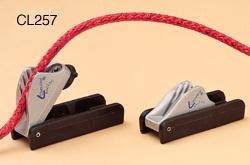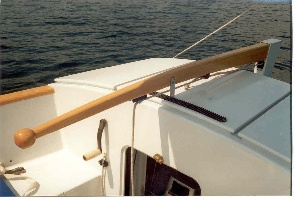Rudder and tiller
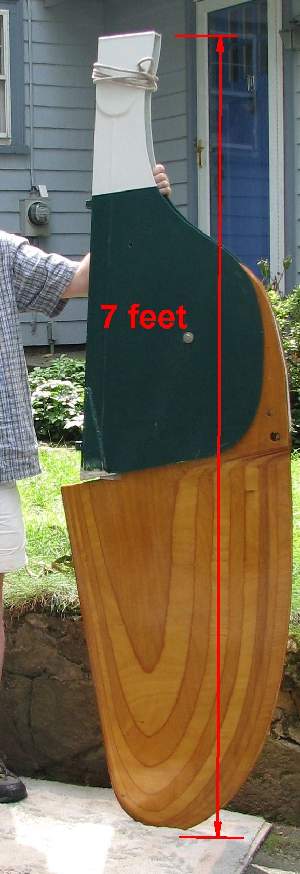 There are many options for the rudder.
The plans I received from Bruce Kirby (before NIS Boats took over distribution) show a fairly simple pivoting rudder blade in a plywood frame.
In contrast, builders in Australia are emphasizing performance with sliding high-aspect blades in kick-up or quick release frames.
I chose to keep the rudder blade pretty much as designed but to make the rudder frame out of aluminum.
The aluminum frame is stronger, better looking and lighter than the wooden frame in the plans.
I have broken rudders in rough conditions several times before so the strength of the assembly is paramount to me.
Light weight is also very important; this boat does not have much buoyancy aft to support a heavy rudder.
And, in our case, we install and remove the rudder every time we sail.
There are many options for the rudder.
The plans I received from Bruce Kirby (before NIS Boats took over distribution) show a fairly simple pivoting rudder blade in a plywood frame.
In contrast, builders in Australia are emphasizing performance with sliding high-aspect blades in kick-up or quick release frames.
I chose to keep the rudder blade pretty much as designed but to make the rudder frame out of aluminum.
The aluminum frame is stronger, better looking and lighter than the wooden frame in the plans.
I have broken rudders in rough conditions several times before so the strength of the assembly is paramount to me.
Light weight is also very important; this boat does not have much buoyancy aft to support a heavy rudder.
And, in our case, we install and remove the rudder every time we sail.
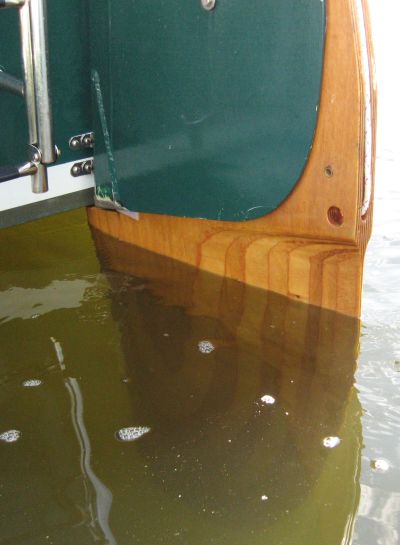
Okay, on to the details for you builders:
Blade
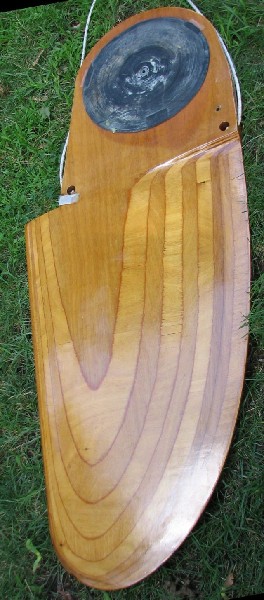 The blade plan shape is pretty much what Kirby designed.
There is a little area ahead of the pivot axis for balance.
The blade is laminated up from three layers of 12mm okoume plywood.
The shape is a NACA 00XX foil shape developed from an on-line calculator from I forget where. "NACA4GEN", I think.
When you find and run the calculator, make the chord length a little longer than actual so the trailing edge can be left a little thick.
It should not be too delicate.
At 36mm thick, the blade is plenty strong but the section is a little narrow for a control foil.
We have not had any trouble with the rudder stalling at low speed.
I made templates by printing out the sections full-size, gluing them to thin stock and cutting them out on the bandsaw.
Cutting the shape is a matter of cutting away wood with whatever tools you have and checking against the templates as you go.
I used hand planes mostly along with rasps and a "Sureform" cheese grater thing.
The blade plan shape is pretty much what Kirby designed.
There is a little area ahead of the pivot axis for balance.
The blade is laminated up from three layers of 12mm okoume plywood.
The shape is a NACA 00XX foil shape developed from an on-line calculator from I forget where. "NACA4GEN", I think.
When you find and run the calculator, make the chord length a little longer than actual so the trailing edge can be left a little thick.
It should not be too delicate.
At 36mm thick, the blade is plenty strong but the section is a little narrow for a control foil.
We have not had any trouble with the rudder stalling at low speed.
I made templates by printing out the sections full-size, gluing them to thin stock and cutting them out on the bandsaw.
Cutting the shape is a matter of cutting away wood with whatever tools you have and checking against the templates as you go.
I used hand planes mostly along with rasps and a "Sureform" cheese grater thing.
The tip of the blade is subject to wear and tear and occasionally outright smashing on rocks.
Someone might even drag it up the boat ramp...
To prevent water from wicking into the blade, I made a barrier by cutting off the end of the blade and gluing it back on with thickened epoxy.
I used a coping saw to make an irregular cut so the the joint would be self-aligning.
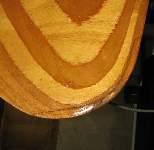
Epoxy in a plastic sleeve for the pivot bolt and for the "hold-up" pin. PVC is easy to work and bonds well with epoxy. Delrin (acetal) would also work.
Coat the whole blade in epoxy and as many coats of varnish as you have patience for (just 3 in my case).
Rudder Frame
Aluminum. The basic structure is a 2" square tube as the rudder post with 3/16" plates welded to the aft face as the cheeks. Cut out the pieces. Take them to a welding shop. Make a spacer so the two cheeks are held the right distance apart.
The uphaul and downhaul lines run through thru-deck blocks into and out of the square tube.
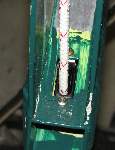

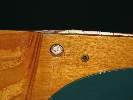
Blade pivot. Some combination of Delrin spacer, washers and sleeves to prevent the pivot bolt from touching the aluminum.
Paint: Keeping paint on aluminum can be difficult. If you can find someone to hard-anodize the rudder frame, that would be the best foundation for paint. Otherwise, you will need some kind of anti-corrosion primer sysem. We used a chromate-epoxy but this is toxic and may not be available in some places.
Stress on the rudder:
The rudder blade transfers bending stress to the frame due to hydrodynamic forces forces on the foil surface. After several years, I noticed cracks in the rudder frame where the cheeks are welded to the post. I had reinforcing plates welded on. While taking these pictures, I saw that a new crack had formed. I took the rudder to get this crack welded up again before our 2-week cruise in Maine this summer. This seems to be the weakest point in this particular rudder.

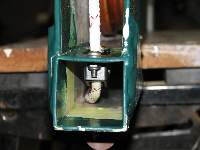
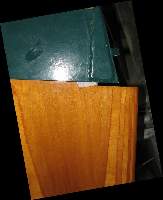
Pintles and gudgeons
Well, lots of gudgeons anyway, 2 on the rudder, 3 on the boat, with a 1/2" SS rod through all. The gudgeons on the rudder frame are machined from aluminum and welded to the square tube. They are bushed with Delrin bushings.
Tiller
The tiller is conventional, laminated from ash. Be sure the fit in the head of the rudder frame is loose enough to allow for swelling in the marine environment.
I had to belt-sand ours and revarnish several times because it was swelling and jamming in the aluminum rudder head.
Details:
- The rudder uphaul and downhaul lines are held halfway along the underside of the tiller by a wooden two-hole fairlead.
- The very essential quick-release cleat for the rudder downhaul is a Clamcleat CL257.
- The tiller comb is made from an automotive timing belt and an offcut from a rigging tang. The NIS steers wild if you let go the tiller while motoring. This is the solution!
